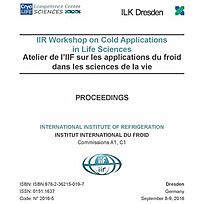
IIR document
Importance of controlled ice formation for efficient cell biobanking.
Number: pap. 007
Author(s) : LAUTERBOECK L., GRYSHKOV O., HOFMANN N., et al.
Summary
Effective long-term storage of rare and clinically relevant cells depends on the cell type and thus requires optimization of the main process parameters involved in cryopreservation. Among these parameters, the cooling and thawing rates, as well as the temperature of nucleation can be adjusted by a specific cryopreservation method. In this work, we reveal the optimal conditions for cryopreservation of human fibroblasts (HF), human pulmonary microvascular endothelial cells (HPMECs), amnion (aMSCs), and bone marrow stem cells (bMSCs) using an electro-freezing method and applying 2.5 %, 5 % or 10 % (v/v) dimethyl sulfoxide (Me2SO) as a cryoprotective agent. The optimal nucleation temperature for freezing of HF was -10 °C for a cooling rate of 1 K·min-1 and -7.5 °C for 5 K·min-1 using 5 % Me2SO. Application of a cooling rate of 5 K·min-1 and induction of the ice formation at -12 °C resulted in 90 % of viable HPMECs. The aMSCs and bMSCs reflected the highest viability of 75 % after freezing using a two-step freezing protocol utilizing a cooling rate of 7.5 K·min-1 down to -30 °C and 3 K·min-1 down to -80 °C. The highest cell viability was observed while inducing the ice formation at -10 °C for both aMSCs and bMSCs.
Available documents
Format PDF
Pages: 6 p.
Available
Public price
20 €
Member price*
Free
* Best rate depending on membership category (see the detailed benefits of individual and corporate memberships).
Details
- Original title: Importance of controlled ice formation for efficient cell biobanking.
- Record ID : 30019496
- Languages: English
- Source: 2nd IIR Workshop on cold applications in life sciences.
- Publication date: 2016/09/08
- DOI: http://dx.doi.org/10.18462/iir.cals.2016.0007
Links
See other articles from the proceedings (25)
See the conference proceedings
Indexing
- Themes: The influence of refrigeration on cells, tissues and organs
- Keywords: Ice; Cryobiology; Cell; Tissue; Nucleation; Expérimentation; Cryopreservation
-
Cryopreservation of adherent cells in 96 well p...
- Author(s) : KILBRIDE P., MAHBUBANI K. T., LAMB S., et al.
- Date : 2016/09/08
- Languages : English
- Source: 2nd IIR Workshop on cold applications in life sciences.
- Formats : PDF
View record
-
Bio-inspired cryopreservation using synthetic p...
- Author(s) : BAILEY T. L., OTTEN L. C., GIBSON M. I.
- Date : 2016/09/08
- Languages : English
- Source: 2nd IIR Workshop on cold applications in life sciences.
- Formats : PDF
View record
-
MORPHOLOGIC ASPECTS OF COOLING EFFECTS ON CELLS...
- Author(s) : JURCENKO T. N.
- Date : 1987/08/02
- Languages : Russian
View record
-
Novel cryo-racks for different applications in ...
- Author(s) : KRETSCHMER R., REINSCH H., HEIDINGSFELDER J., et al.
- Date : 2016/09/08
- Languages : English
- Source: 2nd IIR Workshop on cold applications in life sciences.
- Formats : PDF
View record
-
Newly designed Tissue/cell storage bag for cryo...
- Author(s) : MOTOMURA N., SAITO A., KUROSAKI Y., et al.
- Date : 2016/09/08
- Languages : English
- Source: 2nd IIR Workshop on cold applications in life sciences.
- Formats : PDF
View record
